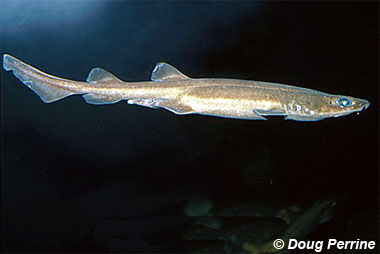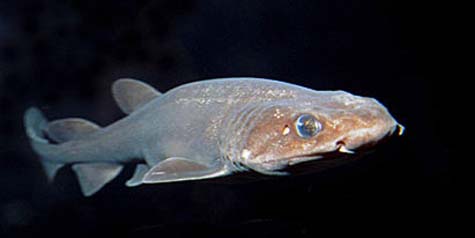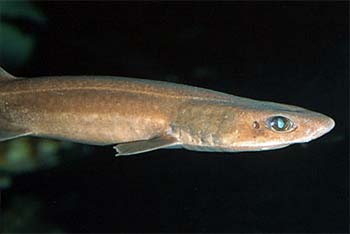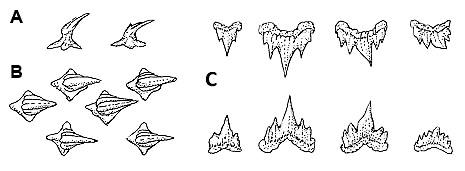Filetail Catshark

Parmaturus xaniurus
This small, soft-bodied shark lives in deep water along the Eastern Pacific so it has larger eyes for low light, and larger gills for lower oxygen levels. It is slender and gray-brown, with lobed fins set further back on its body, and it rarely grows longer than 21 inches long. The name comes from the ridge of toothy denticles (complex scales) along the top of its caudal fin. Because of its size and habitat, it is considered harmless to humans.
Order – Carcharhiniformes
Family – Scyliorhinidae
Genus – Parmaturus
Species – xaniurus
Common Names
English language common names for this species include filetail catshark and filetail cat shark. Other common names include gato lima (Spanish), holbiche râpe (French), and pejegato lima (Spanish).
Importance to Humans

Although not targeted by commercial fisheries, this small demersal shark is often caught as incidental catch in sablefish trap, longline and bottom trawl fisheries. There is a lack of specific catch data. Trawl fisheries do not catch large numbers of filetail catsharks due to the rocky habitat in which they reside. However, longlines which are laid over these rocky areas have a much higher potential for catching adults. The flesh of this catshark is not utilized for human consumption.
In the near future, increased fishing pressure in US waters is thought to be unlikely due to the heavy restrictions places on trawling operations. However, the situation in Mexico needs to be monitored.
Danger to Humans
The filetail catshark is considered harmless to humans due to its small size, habitat preference and feeding habits.
Conservation
> Check the status of the filetail catshark at the IUCN website.
This shark is currently listed by the World Conservation Union (IUCN) as “Data Deficient”. The IUCN is a global union of states, governmental agencies, and non-governmental organizations in a partnership that assesses the conservation status of species. Lack of information on this species precludes the assessment of the filetail catshark as as such, there is no need for any conservation action. However there is a need for species-specific recording of bycatch data from the trawl and longline fisheries which catch the filetail catshark as incidental bycatch. The viability of this in the near future is in doubt due to limits with observers and funding resources.
Geographical Distribution

The distribution range of the filetail catshark is limited to the eastern central Pacific Ocean from the central California (US) coast to the Gulf of California (Mexico).
Habitat
This common catshark is demersal, found over soft mud bottoms of the outer continental shelf and upper slope in temperate to subtropical waters at depths ranging from 300-4,105 feet (91-1,251 m). The juveniles are mesopelagic, found around 1,640 feet (500 m) off the bottom in waters over 3,280 feet (1,000 m) deep. It possesses an enlarged gill region as an adaptation allowing this species to reside in areas of low dissolved oxygen levels. The filetail catshark has been observed from a deep-diving submersible near the bottom of the Santa Barbara Basin, an area which is considered anoxic with few if any other vertebrates. Another interesting note is that it is a neutrally buoyant fish as a result of the high concentration of squalene in its liver.
Biology

Distinctive Features
The filetail catshark is a small, soft-bodied shark possessing a short snout with broad, triangular nasal flaps. The eyes are elongate and oval-shaped with well-developed ridges under the eyes. There are five gill slits on each side, with the posterior two located over the pectoral fin. Spiracles are present on this catshark. There are two dorsal fins of approximately the same size. The origin of the first dorsal fin is located just behind the origin of the pelvic fin while the origin of the second dorsal fin is nearly over the origin of the anal fin. The second dorsal is smaller than the anal fin. The pectoral fins are small and the caudal fin is asymmetrical with a very small or absent lower lobe. The caudal base lacks keels on the sides.

Coloration
The filetail catshark is gray-brown above, lighter below with dark fins. There are no distinctive markings on this shark.
Dentition
The teeth of the filetail catshark are small, each with multiple points.
Size, Age, and Growth
The maximum size of male filetail catsharks is 17.7 inches (45.0 cm) total length (TL) and the maximum size of females is 21.7 inches (55.0 cm) TL. Studies from off the coast of California have determined that males reach maturity at lengths ranging from 14.7-16.7 inches (37.5-42.5 cm) TL and females at lengths of 16.7-18.7 inches (42.5-47.5 cm) TL. Age determination of this species has been difficult due to the absence of growth rings on the vertebrae.
Denticles
There is a prominent crest-like ridge of denticles along the upper edge of the caudal fin.
Food Habits
Prey items of the filetail catshark include small fishes such as lanternfish as well as invertebrates including various mollusks.

Reproduction
As an oviparous species, the female filetail catshark deposits egg cases throughout the year with a higher reproductive output during the late summer months of July through September, thereby indicating high fecundity. The filetail catshark shows site-fidelity in their egg case deposition sites that are found scattered in areas where the adults typically reside. Each egg case measures about 2.8-4.3 inches (7-11 cm) in length by 1.2-1.6 inches (3-4 cm) in width with T-shaped lateral flanges. The egg case nursery areas are located in rocky vertical relief at depths of 985-1,312 feet (300-400 m). It is in these egg cases that the embryos feed solely on yolk until hatching occurs up to 24 months later. Hatchlings measure approximately 2.8-3.5 inches (7-9 cm) TL.

Predators
Although there is a lack of documentation, this shark potentially falls prey to larger fish and other sharks. The juveniles are easy prey for a variety of species while the egg cases are susceptible to predation by thornyhead rockfishes (Sebastolobus spp.), sea stars, and boring gastropods.
Taxonomy
The filetail catshark was originally described as Catulus xaniurus by Gilbert in 1892. This name was later changed to the currently valid Parmaturus xaniurus (Gilbert 1892). A member of the catshark family, Scyliorhinidae, it gets the common name filetail catshark from the crest-like row of tooth-like projections along the upper edge of the caudal fin (tail).
Prepared by: Cathleen Bester